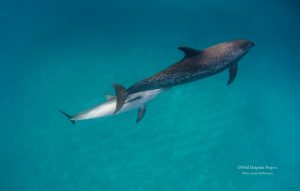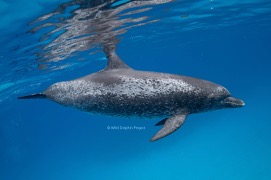From Calf to Spotted Adult: The Life Cycle of an Atlantic Spotted Dolphin
By Wild Dolphin Project
When it comes to raising a dolphin, moms do a lot of the heavy lifting—literally. Like all marine mammals, Atlantic spotted dolphins give birth to live young after a pregnancy that lasts around 12 months. Calves are usually born in the spring and fall, when ocean conditions are a little more favorable, and the waters are warm.
From the start, dolphin calves are fully dependent on their mothers. Within moments of birth, after being born tail first, the calf swims to the surface for its first breath, guided gently by its mother. Nursing begins almost immediately. The calf drinks rich, fatty milk from specially positioned mammary slits on the mother’s underside, getting all the nutrition it needs to grow fast and strong.

Female dolphins show varying levels of reproductive success—not all pregnancies result in surviving offspring. However, in some cases, multiple generations can be seen together in the same social group, including grandmothers, daughters, grandchildren, and even great-grandchildren. It’s not uncommon to observe a grandmother and her daughter each with new calves, swimming side by side. Some females who do not reproduce successfully may still play an important role in the group, acting as caregivers or “babysitters” to younger calves within the family.
Calves nurse for about 2–3 years, although they’ll begin sampling fish earlier as they learn to hunt. During this time, mothers and calves form an especially tight bond. We often see them swimming in near-perfect synchrony—mom on the outside, calf tucked safely in her “slipstream” for less resistance.

Atlantic spotted dolphin calf nurses from mom.
As they grow, young dolphins begin to branch out socially, learning from other group members and starting to form their own bonds. It’s a long learning process. In fact, dolphins don’t reach full sexual maturity until they’re around 8–15 years old, depending on the individual. That means adolescence can be a lengthy, playful, and very social period.
Spotting the Changes: Color Phases in Atlantic Spotted Dolphins
One of the unique things about Atlantic spotted dolphins (Stenella frontalis) is that we can often estimate their age just by looking at their spots. They go through distinct color phases as they grow, kind of like biological age badges. Here’s a breakdown:
-
Two-tone (newborn–~3 years): Calves are born with smooth, gray skin and a light underside. They’re sometimes called “two-tone” because of the sharp contrast in their coloring. About 25% of dolphin calves don’t survive their first year, often due to natural causes or predators like sharks. To help protect them, mothers with calves often form nursery groups. These groups give young dolphins the chance to socialize, play, and build early bonds—skills that are important for life in a complex social species.

-
Speckled (~4–8 years): As dolphins begin to mature, they develop tiny dark spots on their belly and side. When a mother becomes pregnant again, her older calf typically transitions into juvenile groups. Young females often stay near their mothers, possibly to gain experience caring for calves. In contrast, juvenile males start forming early bonds that can lead to future alliances, often engaging in play-fighting and other social behaviors. This stage of life comes with higher risks—gaining independence can make young dolphins more curious and adventurous, which may increase their vulnerability to predators and other dangers.

-
Mottled (~9–15 years): The spotting becomes more obvious and covers more of the body. It’s a mix of dark and light spots across the back and belly, often giving a “mottled” look.
-
Fused (~15+ years): By the time Atlantic spotted dolphins reach around 15 years of age, their spots begin to coalesce into denser patterns—a sign of full physical maturity. By this age, many females will have had one or two calves, and over their approximately 30-year reproductive span, they may produce up to 10 offspring. Estrus can occur two to three times per year, and males are quick to detect this, often pursuing females during these fertile windows.
At this stage, males are sexually mature and capable of siring calves. They may exhibit physical signs of heightened reproductive activity, including increased testes size and a noticeable “ventral keel,” which is a temporary thickening along the belly. Male coalitions—stable bonds formed earlier in life—remain strong and play a critical role during mating, with males working together or competing for access to receptive females.
Atlantic spotted dolphins can live into their early 50s, but full physical maturity isn’t typically reached until around 25 years old, making the second and third decades of life a dynamic period for both social and reproductive development.

Fused “color phase” of an Atlantic spotted dolphin.
These color changes don’t just help researchers identify individual dolphins—they also offer valuable clues about the social structure, reproductive status, and even group dynamics of a pod.
Understanding the life cycle and development of dolphins helps us better protect them. From nursing calves to older fused adults, each stage is critical for the health and future of the population.

